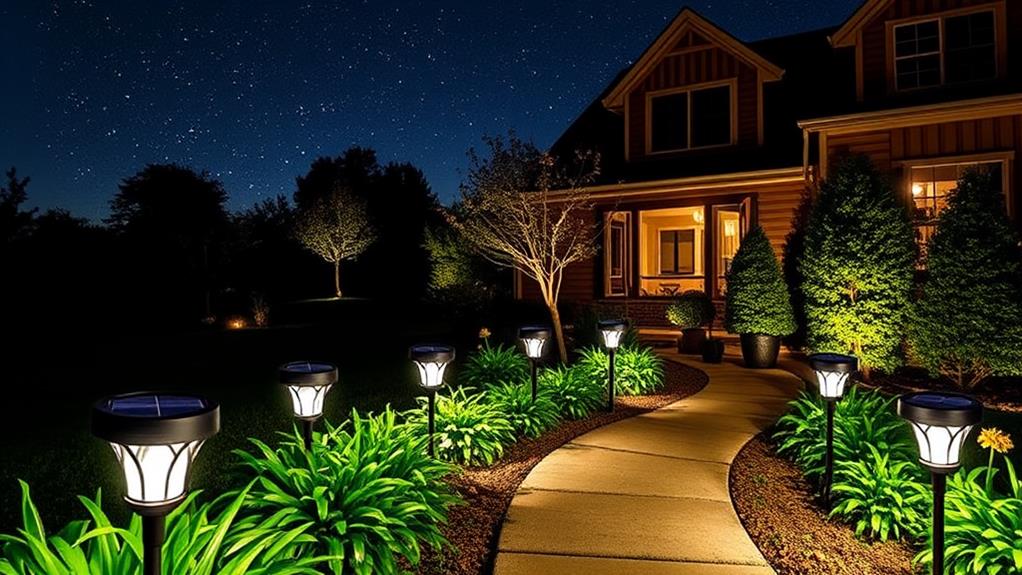Energy-efficient outdoor lighting solutions can dramatically reduce your energy consumption while enhancing safety and aesthetics. LED technologies offer long-lasting, durable fixtures that consume up to 75% less energy than traditional lighting. Solar-powered options eliminate the need for grid electricity, while motion sensors and smart controls optimize energy usage. Dark sky compliant lighting minimizes light pollution and protects nocturnal wildlife. For landscape lighting, consider low-voltage systems and zone lighting to focus illumination where needed. You can also retrofit existing fixtures with energy-efficient bulbs and add timers or photocells. Exploring these options will illuminate a path to significant energy savings and environmental benefits.
LED Lighting Technologies
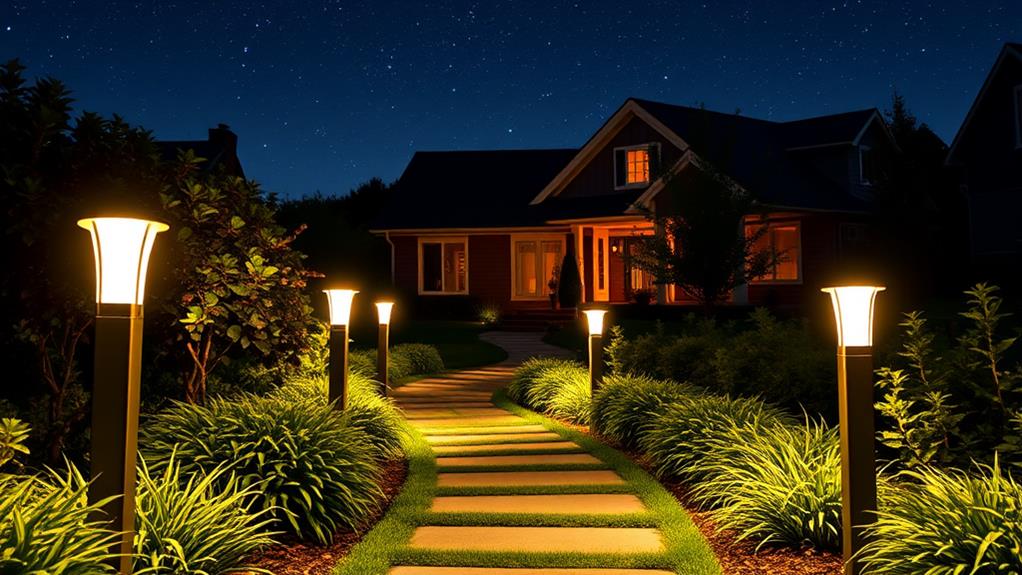
While traditional outdoor lighting has relied on inefficient technologies, LED lighting has revolutionized the industry. LED lights offer numerous advantages for outdoor applications, including energy efficiency, long lifespan, and durability.
You'll find that LEDs consume up to 75% less energy than traditional lighting sources, significantly reducing your electricity costs and carbon footprint.
LED lights also last much longer than conventional bulbs, with lifespans of up to 50,000 hours or more. This longevity means you'll spend less time and money on replacements and maintenance. Additionally, LEDs are highly durable and resistant to shock, vibration, and extreme temperatures, making them ideal for outdoor use.
You can choose from a wide range of color temperatures and intensities with LED lighting, allowing you to create the perfect ambiance for your outdoor spaces. Many LED fixtures also offer dimming capabilities and smart controls, enabling you to adjust lighting levels based on time of day or occupancy.
When selecting LED outdoor lighting, consider factors such as lumens output, color rendering index (CRI), and IP rating for weather resistance. By investing in high-quality LED lighting solutions, you'll enjoy improved energy efficiency, reduced maintenance costs, and enhanced outdoor illumination for years to come.
Solar-Powered Outdoor Fixtures
LED lighting offers significant energy savings, but solar-powered outdoor fixtures take efficiency to the next level. These innovative solutions harness the sun's energy to illuminate your outdoor spaces, eliminating the need for grid electricity. You'll find a wide range of solar-powered options, from pathway lights and spotlights to security fixtures and decorative lanterns.
Solar outdoor lighting typically consists of a solar panel, rechargeable battery, LED light, and photosensor. During the day, the panel converts sunlight into electricity, which is stored in the battery. At dusk, the photosensor activates the light, using the stored energy to power the LEDs throughout the night. You'll benefit from reduced energy costs and lower carbon emissions, while enjoying hassle-free installation without the need for wiring.
When choosing solar-powered fixtures, consider factors like light output, battery capacity, and durability. Look for models with high-efficiency solar panels and long-lasting batteries to ensure reliable performance, even during cloudy periods. Many modern solar lights also offer smart features like motion sensors, adjustable brightness, and remote control options, allowing you to customize your outdoor lighting experience while maximizing energy efficiency.
Motion Sensor Lighting Systems
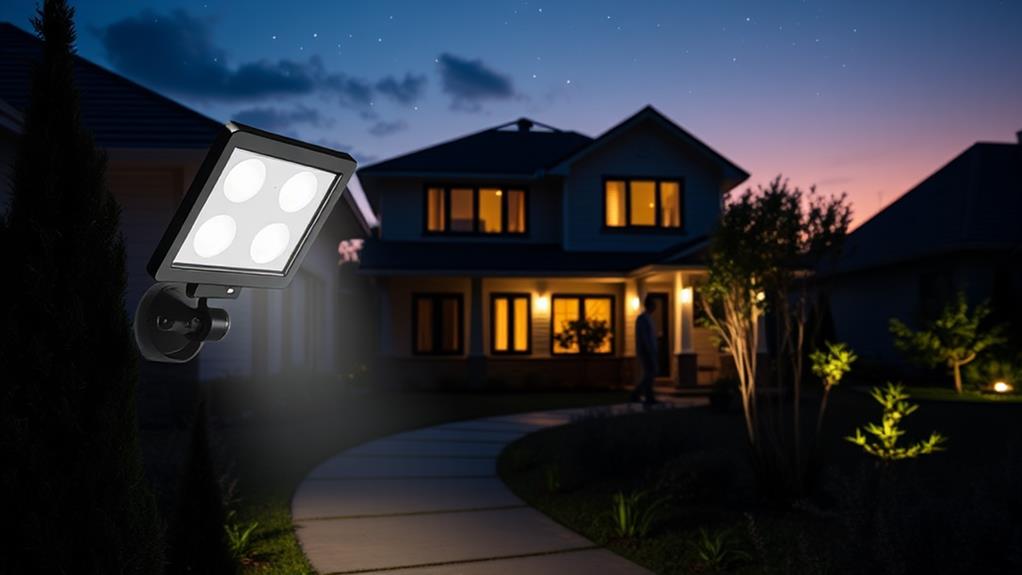
Motion sensor lighting systems offer another layer of energy efficiency and convenience for outdoor illumination. These systems automatically activate lights when they detect movement within their range, ensuring that you're not wasting energy by keeping lights on when they're not needed.
You'll find various types of motion sensors available, including passive infrared (PIR), microwave, and dual-technology sensors. PIR sensors detect body heat and are the most common for outdoor use. They're cost-effective and reliable in most conditions. Microwave sensors emit radio waves to detect movement and can cover larger areas but may be more prone to false triggers. Dual-technology sensors combine both PIR and microwave technologies for enhanced accuracy.
When installing motion sensor lights, consider their placement carefully. Position them to cover key areas like entryways, driveways, and pathways. Adjust the sensitivity and range settings to avoid unnecessary triggering by passing cars or small animals. Many modern systems allow you to customize the duration lights stay on after activation, further optimizing energy usage.
Smart Lighting Control Solutions
Smart lighting control solutions take energy efficiency and convenience up to the next level for outdoor illumination. These systems allow you to manage your outdoor lights remotely, adjusting brightness, color, and timing to suit your needs and save energy.
With smart lighting controls, you can create custom schedules for your outdoor lights. You'll be able to program them to turn on at sunset and off at sunrise, or set specific times for different areas of your property. Many systems also offer geofencing capabilities, automatically activating lights when you approach home.
You can integrate smart outdoor lighting with other home automation systems, enabling voice control through virtual assistants like Alexa or Google Home. Some solutions even adapt to weather conditions, adjusting brightness on cloudy days or during storms.
These systems often come with mobile apps, allowing you to monitor and control your outdoor lighting from anywhere. You can check energy usage, receive alerts about malfunctioning lights, and make real-time adjustments. By optimizing your outdoor lighting schedule and intensity, you'll significantly reduce energy consumption and extend the lifespan of your bulbs, leading to long-term cost savings and a smaller environmental footprint.
Dark Sky Compliant Lighting
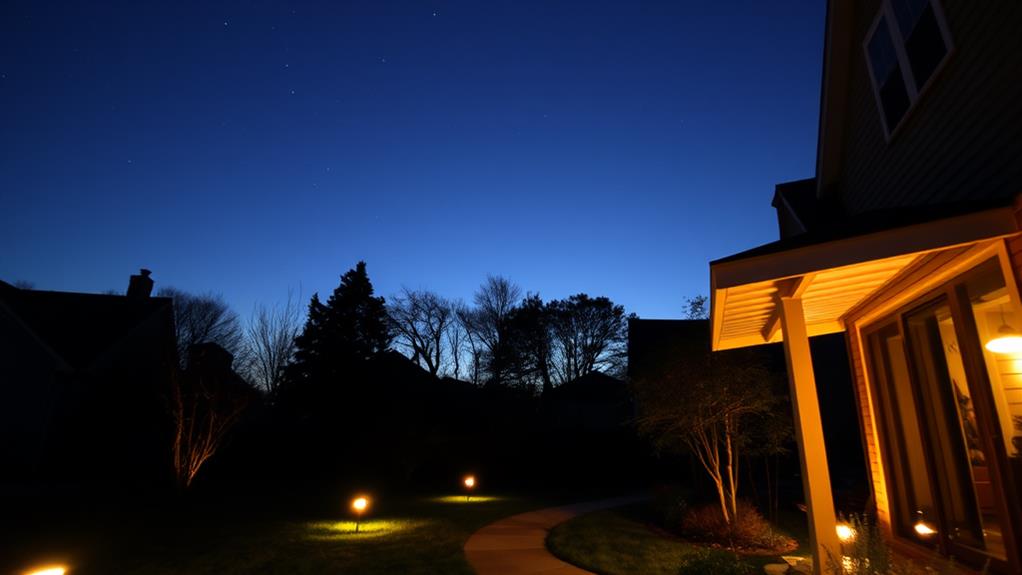
Dark sky compliant lighting represents a crucial step in reducing light pollution and preserving our night skies. When you choose dark sky compliant fixtures, you're not only saving energy but also protecting nocturnal wildlife and maintaining the natural beauty of starry nights.
To implement dark sky compliant lighting, you'll need to focus on several key factors. First, select fixtures that direct light downward and minimize upward light spill. Look for fully shielded or full cut-off designs that concentrate illumination where it's needed most.
You should also opt for warm-colored LEDs with a color temperature of 3000K or lower, as these emit less blue light that can disrupt ecosystems and human sleep patterns.
Consider using timers, motion sensors, or dimming controls to reduce light output when full brightness isn't necessary. This approach not only saves energy but also lessens the impact on the environment. When planning your outdoor lighting, use only the amount of light required for safety and functionality.
Energy-Efficient Landscape Lighting
Landscape lighting's energy efficiency has become a top priority for homeowners and businesses alike. You can significantly reduce your energy consumption and costs by implementing smart lighting strategies in your outdoor spaces. LED lights are the most energy-efficient option, using up to 75% less energy than traditional incandescent bulbs while lasting much longer.
To maximize efficiency, consider using solar-powered landscape lights. These fixtures harness the sun's energy during the day and illuminate your garden at night, eliminating the need for electrical wiring. For areas that require more consistent lighting, opt for low-voltage systems that operate at 12 volts instead of the standard 120 volts.
Don't forget to incorporate lighting controls such as timers, motion sensors, and photocells. These devices ensure your lights are only on when needed, further reducing energy consumption. Zone lighting is another effective technique, allowing you to illuminate specific areas independently. By focusing light where it's needed most, you'll avoid unnecessary energy waste while creating a more visually appealing landscape. Remember, energy-efficient landscape lighting not only saves you money but also contributes to a more sustainable environment.
Retrofitting Existing Outdoor Lights
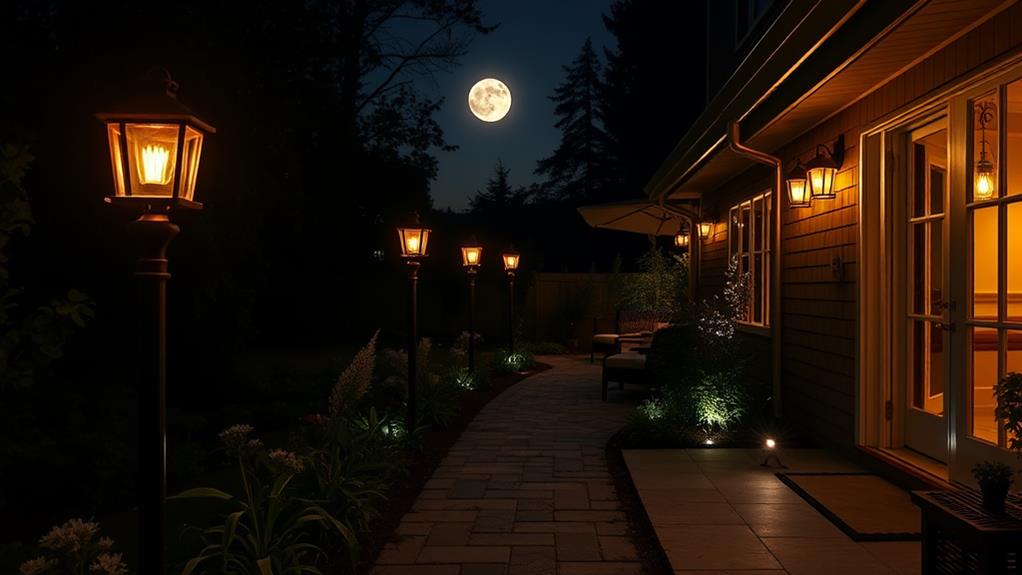
While upgrading your entire landscape lighting system is ideal, it's not always feasible. Fortunately, you can still improve energy efficiency by retrofitting your existing outdoor lights.
Start by replacing old incandescent bulbs with LED equivalents. LEDs use up to 75% less energy and last much longer, reducing both your electricity bills and maintenance costs.
Next, consider installing motion sensors or photocells on your outdoor fixtures. Motion sensors will activate lights only when needed, while photocells ensure lights turn on at dusk and off at dawn automatically. You can also add timers to your existing system, allowing you to control when lights are on and for how long.
Don't forget about your fixtures themselves. Clean them regularly to maximize light output and reduce the need for higher wattage bulbs. If possible, replace old fixtures with more energy-efficient models that direct light where it's needed, minimizing light pollution and wasted energy.
Lastly, adjust your lighting habits. Turn off unnecessary lights and use lower wattage bulbs where appropriate. By implementing these retrofitting strategies, you'll significantly reduce your energy consumption without the need for a complete system overhaul.
Timers and Photocells
For optimal energy efficiency in outdoor lighting, timers and photocells play a crucial role. These devices ensure your lights operate only when needed, significantly reducing energy waste and costs.
Timers allow you to set specific on/off schedules for your outdoor lights. You can program them to activate at dusk and turn off at dawn or during late-night hours when they're not necessary. Digital timers offer more flexibility, allowing you to create multiple schedules for different days of the week or seasons.
Photocells, also known as daylight sensors, automatically control your lights based on ambient light levels. They'll turn your lights on when it gets dark and off when there's sufficient natural light. This feature is particularly useful for security lighting and areas where consistent illumination is required after dark.
You can combine timers and photocells for even greater efficiency. For example, use a photocell to activate your lights at dusk, then employ a timer to shut them off during the middle of the night. This setup ensures your lights aren't unnecessarily burning energy during the pre-dawn hours when they're least likely to be needed.
Efficient Street Lighting Options
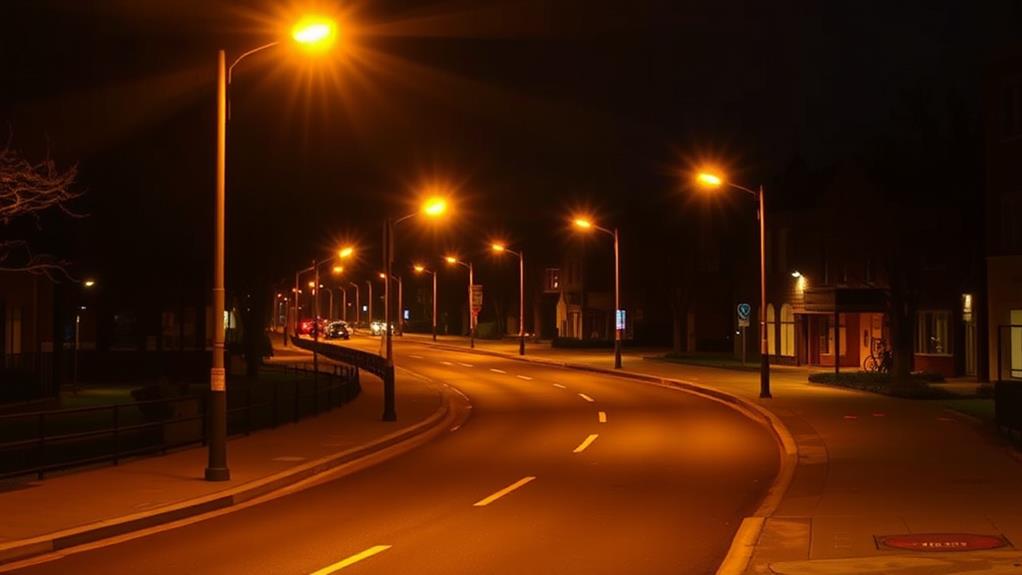
In the realm of urban infrastructure, efficient street lighting options have become increasingly vital. You'll find several cutting-edge solutions that can significantly reduce energy consumption and maintenance costs while improving visibility and safety.
LED streetlights are at the forefront of this revolution. They consume up to 50% less energy than traditional high-pressure sodium lamps and last much longer, reducing replacement frequency. You can opt for smart LED systems that adjust brightness based on traffic patterns or time of night, further enhancing energy savings.
Solar-powered streetlights are another excellent option, especially in areas with ample sunlight. They're completely off-grid, eliminating electricity costs and reducing carbon emissions. You'll find these lights particularly useful in remote locations or areas prone to power outages.
Induction lighting is a lesser-known but highly efficient alternative. These lights have a long lifespan and maintain their brightness over time, making them ideal for hard-to-reach areas. You'll appreciate their instant-on capability and excellent color rendering.
Lastly, consider plasma lighting for large outdoor spaces. It offers high-quality light with excellent color accuracy and energy efficiency. You'll find it particularly suitable for stadiums, parking lots, and industrial areas.
Conclusion
You've now illuminated the path to energy-efficient outdoor lighting. By embracing these solutions, you'll not only reduce your carbon footprint but also save money in the long run. Whether you're lighting up your backyard or an entire city street, there's a sustainable option waiting to brighten your night. So why stay in the dark ages of wasteful lighting? Step into the future and let your outdoor spaces shine with eco-friendly brilliance.
